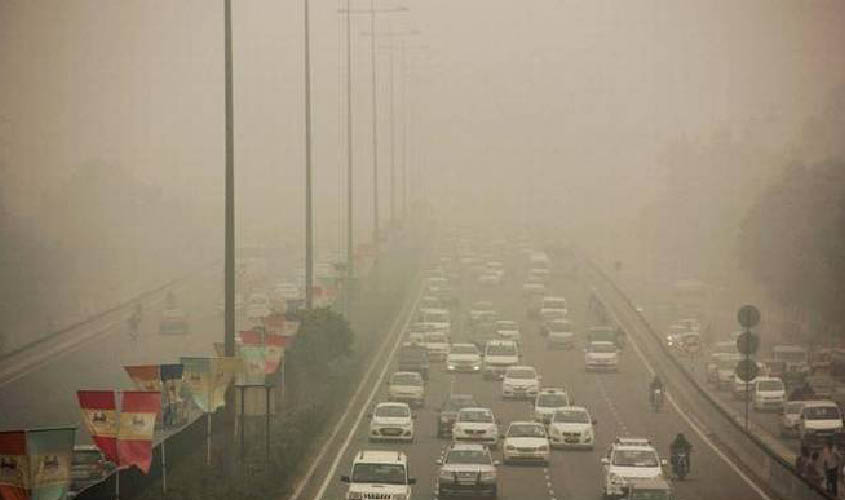‘Rise in vehicular pollution and crop buring during Diwali period main culprits’.
Delhi’s air quality is likely to worsen further as air pollution increases due to vehicular pollution, crop burning and the approaching western disturbances around the national capital region (NCR) during the Diwali period.
Like every year, pollution levels have once again spiked, with air quality levels reducing from very poor to unhealthy levels across all parts of the NCR.
According to a new study released by TERI (The Energy and Resources Institute), 28% of the total pollution levels in Delhi are contributed by vehicles in Delhi, while crop burning contributes to only 4% of the total pollution levels in Delhi-NCR.
Private cars contribute about 3% of the total PM (particulate matter) 2.5 pollutants, while two wheelers contribute about 7% of the total PM 2.5 pollutants. Heavy vehicles, including tractors and trucks, contribute about 9% and three wheelers and buses about 5% and 3% respectively to the PM 2.5 polluting matters into the air.
According to data from the Ministry of Earth Sciences, 40% of the total pollution is contributed by vehicles plying in the Delhi-NCR region.
The TERI research has also said that crop burning, which lasts for about 15-20 days during this period, contributes to just 4% of the total pollution in Delhi-NCR on an average.
- Suresh, fellow and convenor of TERI, told The Sunday Guardian, “We need to implement cleaner fuels like BS IV on an urgent basis to tackle this pollution menace in Delhi. We also need to shift to electric vehicles and improve our public transport system so that people have faith in leaving their cars back home and travel safe and hassle free to and from work daily. Congestion is another major problem which causes a lot of pollution; we need to reduce congestion on Delhi roads for better pollution management.”
Environmentalists have also raised concerns about vehicular pollution in Delhi. Delhi has more than one crore cars registered and over one-and-a-half crore vehicles plying on Delhi roads. They have also raised fears of more congestion and vehicular pollution during this period of festivity when people in Delhi swarm the streets on their vehicles to visit their loved ones.
Some have also argued about stopping of registration of all private vehicles in Delhi for the next one or two years to curtail the explosion of number of cars in Delhi. Others have said that with no adequate public transport facility available in the Delhi-NCR region, it would become impossible commuting in Delhi.
Anumita Roychowdhury, Executive Director, Centre for Science and Environment, told The Sunday Guardian, “We know that vehicular pollution has increased the maximum in Delhi since 2010 and it contributes to about 40% of the total pollution levels in Delhi, which is close to half of all polluting matters in Delhi. How can we not touch them (cars)? We will have to have a policy to restrict the usage of cars during an emergency. For the long term, we need to ensure that a parking policy is put in place. The draft on parking policy is ready, but it is not being notified due to the fear of car owners. Why should those who park cars illegally not be prosecuted? Why should one not pay for parking vehicles in public places, be it even outside their houses?”
Environmentalist Anil Sood also questioned about the rising pollution levels at Dwarka, which is considered among one of the most planned sub cities of Delhi-NCR, with most residential colonies having a huge green cover in the area.
According to Sood, in the last seven days, the air quality in Dwarka has remained severe to very poor. He has blamed the airport nearby and the flying of aircraft for the increasing pollution levels in this region.
“Aircraft engines produce emissions that are similar to other emissions resulting from fossil fuel combustion. Aviation Turbine Fuel (ATF) is refined kerosene oil. It is made from middle distillate of crude. ATF gives more ash than petrol. On the ground before leaving the airport and during the taxiway to the runway, an aircraft consumes around 300 litres of ATF. Due to traffic congestion both in the morning and evening, the aircraft engine runs idle for some time waiting for its turn, thereby increasing the quantity of ATF consumed. For one traffic movement from taxi to takeoff and leaving the Dwarka air space, one flight consumes about 1,000 litres of air fuel. This is hazardous,” Sood said.

